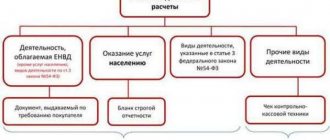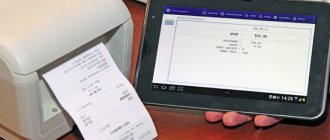Most commercial enterprises constantly work with cash and undertake to transfer the profits received to the bank for safekeeping on time. At the same time, the manager cannot send every penny to the organization’s account - at the end of the work shift, the cash register limit. For whom does it apply, how to calculate it and formalize it correctly?
Are you switching to an online checkout? We will select a cash register for your business in 5 minutes.
Leave a request and get a consultation.
We decipher the concept of “cash limit”
In simple terms, the phrase “cash limit” is deciphered quite simply: this is the maximum allowable amount of cash in the cash vault, safe or cash register of a commercial company at the end of the day.
This norm was introduced by the Central Bank of the Russian Federation, and the accounting department of an enterprise must set this limit individually at the beginning of each calendar year. Setting and maintaining a cash limit is a headache for many accountants. In order to avoid surpluses, they have to constantly monitor cash, and if in the evening there is suddenly more money in the cash register than the established norm, then the accounting representative needs to go to the bank to deposit funds into the company’s current accounts. Otherwise, it is unlikely that you will be able to avoid administrative punishment during any inspection.
Why do you need a cash limit?
The procedure for establishing a cash balance limit is currently regulated by Bank of Russia Directive No. 3210-U dated March 11, 2014 “On the procedure for conducting cash transactions by legal entities and the simplified procedure for conducting cash transactions by individual entrepreneurs and small businesses.” This document came into force on June 1, 2014; until that moment, a different procedure for conducting cash transactions was in force - established by the Regulation of the Bank of Russia dated October 12, 2011 No. 373-P “On the procedure for conducting cash transactions with banknotes and coins of the Bank of Russia on the territory of the Russian Federation "
In accordance with Bank of Russia Directive No. 3210-U, the cash balance limit is the maximum allowable amount of cash that can be kept in the cash register after the amount of cash balance at the end of the working day is displayed in the cash book. The amount of money exceeding the established limit must be kept in bank accounts. Storing “extra-limit” amounts of money at the cash desk is allowed only on certain days (paragraph 8, clause 2 of Bank of Russia Directive No. 3210-U):
- intended for payment of wages, payments included in the wage fund, scholarships, social payments - no more than five working days, including the day of receipt of cash from a bank account for these payments (paragraph 1, clause 6.5, clause 6 of the Bank of Russia Instructions No. 3210-U);
- weekends – in case of conducting cash transactions on these days;
- non-working holidays - in case of conducting cash transactions on these days.
In other cases, the accumulation of cash in the cash register in excess of the established limit entails administrative liability in the form of a fine (Article 15.1 of the Code of Administrative Offenses of the Russian Federation):
- from 4 thousand rubles to 5 thousand rubles - for officials and individual entrepreneurs;
- from 40 thousand rubles to 50 thousand rubles - for legal entities.
The current procedure for conducting cash transactions in the Russian Federation provides for the right to refuse to establish a cash balance limit for the following categories of economic entities (paragraph 10, clause 2 of Bank of Russia Directive No. 3210-U):
- legal entities related to small businesses;
- individual entrepreneurs, regardless of the taxation system applied.
Please note: In order to exercise the right not to set a cash limit, organizations do not need to register in special registers of small businesses (in regions where such registers are maintained) - there is no such requirement in Bank of Russia Directive No. 3210-U. It is enough only to actually comply with the criteria established for small businesses (clause 1, article 4 of the Federal Law of July 24, 2007 No. 209-FZ “On the development of small and medium-sized businesses in the Russian Federation”):
- the average number of employees for the previous calendar year is no more than 100 people;
- revenue from the sale of goods, works, services excluding VAT for the previous calendar year – no more than 800 million rubles. (Resolution of the Government of the Russian Federation dated July 13, 2015 No. 702). The specified value applies from July 25, 2015; before this day, the revenue limit was 400 million rubles.
- the share of participation in the authorized capital of other legal entities that are not small or medium-sized businesses is no more than 25%;
- the total share of participation of the Russian Federation, its constituent entities, municipalities, foreign legal entities, public and religious organizations or associations, charitable and other foundations in the authorized capital of a legal entity does not exceed 25%.
Individual entrepreneurs and small businesses can refuse to set a cash balance limit and keep an unlimited amount of cash proceeds in the cash register from June 1, 2015. Organizations that acquired the status of a small business entity after June 1, 2015, receive the right to waive the cash limit starting from the day they acquired such status. For example, the organization’s revenue for 2014 amounted to 500 million rubles, all other criteria for classification as an SMP were met. Thus, from July 25, 2015 (when the revenue limit for SMP was increased from 400 million rubles to 800 million rubles), the organization acquired the status of SMP and, accordingly, the right to refuse the cash register limit.
In order to exercise your right to refuse to set a cash balance limit, you must:
- cancel the previously valid order establishing a cash balance limit;
- issue an order according to which, from a certain date, a limit on the cash balance is not established.
Please note : If the above order is missing, then when checking cash discipline, inspectors can either accept the limit approved by the order before 06/01/2014 as the established cash balance limit, or, even worse, consider that the limit has not been established. In the latter case, the cash balance limit is assumed to be zero, that is, any amount of cash in the cash register will be considered “over the limit”.
Is it necessary to set a cash balance limit?
The cash balance limit at the end of the working day is established by all enterprises working with cash, except for those classified as small enterprises. Individual enterprises also may not set a cash balance limit.
As it was before
Previously, absolutely all enterprises and organizations dealing with cash had to limit the remaining funds in the cash register. Since June 2014, this practice has changed: now some business representatives may not set limits. It is not surprising that many wanted to exercise this right.
However, audits carried out by tax authorities discovered some violations caused by insufficient knowledge of the legislative framework regarding the unlimited maintenance of cash balances and, as a result, applied penalties to a number of enterprises and organizations.
That is why, in order to avoid claims from tax authorities, you need to exercise your right to an unlimited cash register competently and with a clear understanding of all the rules of this process.
What are the risks of exceeding the limit?
If you exceed the cash balance limit and do not deposit the difference in a timely manner to the bank, then administrative liability will follow. The fine in this case ranges from 40,000 to 50,000 rubles. for organizations. An official, for example the head of an organization or an entrepreneur, will pay from 4,000 to 5,000 rubles for such a violation. This procedure is established by Articles 2.4 and 15.1 of the Code of the Russian Federation on Administrative Offences.
Important detail. Cases related to violation of the cash balance limit are considered by tax inspectorates (Article 23.5 of the Code of Administrative Offenses of the Russian Federation). Since such a violation is not ongoing, inspectors have the right to hold the organization accountable only within two months from the date of its commission (and not from the date of discovery). This conclusion follows from the provisions of Part 1 of Article 4.5 and Subparagraph 6 of Part 1 of Article 24.5 of the Code of the Russian Federation on Administrative Offenses and is confirmed by arbitration practice (see, for example, resolutions of the Federal Antimonopoly Service of the North-Western District dated June 20, 2006 No. A56-49021/2005, North Caucasus District dated December 13, 2005 No. F08-5915/2005-2341A).
Situation: can an organization be fined for exceeding the cash balance limit? The limit was exceeded due to late arrival of collectors. The collection schedule is established by agreement with the bank.
No you can not.
As a general rule, a guilty action (inaction) of an organization or official is recognized as an offense (Article 2.1 of the Code of Administrative Offenses of the Russian Federation). Consequently, liability for violating the cash balance limit occurs only if the guilt of the organization and (or) its leader is proven (Article 15.1 of the Code of Administrative Offenses of the Russian Federation). Guilt may be expressed in the fact that the organization and (or) its leader:
- sought to accumulate an excess balance (Clause 1, Article 2.2 of the Code of Administrative Offenses of the Russian Federation);
- foresaw the accumulation of an excess balance, but did not prevent it (clause 2 of article 2.2 of the Code of Administrative Offenses of the Russian Federation);
- did not expect the accumulation of an excess balance, although they should have and could have foreseen it (clause 2 of article 2.2 of the Code of Administrative Offenses of the Russian Federation).
Advice: to prove that the organization is not at fault for violating the cash balance limit, record the fact of late arrival of collectors in the act.
In the situation under consideration, the excess balance arose due to the fault of the bank, which did not fulfill the terms of the collection agreement. If the organization documents this fact (indicating the date and time of the violation), it will not be possible to hold it accountable. This conclusion is confirmed by arbitration practice (see, for example, the resolution of the Federal Antimonopoly Service of the North-Western District dated August 17, 2007 No. A56-50165/2006).
Who sets the cash balance limit and how?
To answer all these questions, let us turn to Appendix 2 of the Bank of Russia Instructions dated March 11, 2014 No. 3210-U (as amended on June 16, 2017 No. 4416-U) “On the procedure for conducting cash transactions by legal entities and the simplified procedure for conducting cash transactions by individual entrepreneurs and small businesses."
Which companies may not install it?
The size of the cash balance must be established by all legal entities, regardless of their legal form and the taxation system used.
According to paragraph 2 of the Directive of the Central Bank of Russia No. 3210-U, an exception is made for small businesses, which include individual entrepreneurs. These business participants are allowed a simplified scheme for conducting cash transactions without approval of a limited balance.
A company is classified as a small business if it meets the following criteria:
- annual revenue does not exceed 800 million rubles;
- the average number of employees is no more than 100 people;
- the share of third parties in the authorized capital is not higher than 49%.
If an organization suddenly has the right to cancel the limit, it can do so at any time. To do this, it is necessary to issue an appropriate order. Only its presence means that the company can keep any amount of money in the cash register and dispose of cash at its discretion.
With whom should the established cash standard be agreed upon?
The maximum cash limit is clearly regulated by an administrative act of the management of a company or individual entrepreneur who wishes to limit the amount of the daily cash balance.
The issuance of a corresponding order by the manager is a sufficient procedure for putting this limit into effect.
There is no need to coordinate this restriction with the tax service, the servicing commercial bank, or other external entities.
You just need to follow the generally binding procedure for calculating such a limit.
How often can I change sizes in a company?
The organization, at its own discretion, establishes or revises the period during which a given cash balance limit should be in effect.
The order approving the cash limit usually only mentions the date of entry into force of such a limitation.
Thus, the maximum cash limit established by a specific order of management can be valid at the enterprise for several years, and can be adjusted monthly if there is a real need for this.
Whether it is necessary to annually establish and review the current standard is not enshrined in legislation.
It is advisable to review (adjust) this limit in the following cases:
- the amount of incoming cash revenue has changed significantly;
- the amount of cash spent has increased or decreased significantly.
For how long is the limit set?
This issue has not been resolved by law. The enterprise itself determines the frequency of setting the limit on the cash balance in the cash register.
What document establishes the cash limit?
The cash limit is not agreed upon with the bank. The organization and individual entrepreneur approve it independently by issuing an order signed by the director or individual entrepreneur. The cash limit, at the discretion of the manager, is approved for any period (month, quarter, year, etc.). After the expiration of the specified period, a new order is issued. The deadline may not be specified in the order, and then you can work with this limit for several years until you approve a new document with new calculations.
Example document
LLC "Success"
ORDER No. 0001 dated 01/11/2016 On establishing a limit on the cash balance of an enterprise In accordance with the Directive of the Bank of Russia dated 03/11/2014 No. 3210-U “On the procedure for conducting cash transactions by legal entities and the simplified procedure for conducting cash transactions by individual entrepreneurs and small entities entrepreneurship" and based on the calculation of the cash balance limit in the cash register, determined based on the volume of cash dispensed from the cash register, I order: 1. Establish from 01/01/2016 a cash balance limit in the cash register in the amount of 60,606 (sixty thousand six hundred six) rubles.
Appendix: Calculation of the cash balance limit in the cash register.
Director _______________ Full name
Limit for cash payments with individual entrepreneurs
Individual entrepreneurs, like legal entities, are classified as participants in cash payments. Therefore, when making payments to individual entrepreneurs, you must comply with the cash payment limit (RUB 100,000 within one agreement) in the same way as when making payments to legal entities.
In an amount not exceeding this amount, the following must be calculated among themselves:
- two individual entrepreneurs;
- Individual entrepreneur and legal entity. In this case, it is necessary to take into account additional restrictions established for microfinance organizations, credit consumer cooperatives and agricultural credit consumer cooperatives.
Conducting cash transactions
In accordance with Directive No. 3210-U, “legal entities and individual entrepreneurs can conduct cash transactions electronically. Cash transactions are formalized by incoming cash orders 0310001, outgoing cash orders 0310002 (hereinafter referred to as cash documents).
Cash documents can be drawn up:
- Chief accountants, bookkeepers, or other officials with whom an agreement for accounting has been concluded, as well as managers (in the absence of a chief accountant and accountant).
- Cash documents are signed by the chief accountant or accountant (in their absence by the manager), as well as by the cashier.
- The cashier is provided with a seal (stamp) containing details confirming the cash transaction, as well as sample signatures of authorized persons.
Cash received at the cash register and cash issued from the cash register are recorded in cash book 0310004.
Responsibility for conducting cash transactions
The absence of primary documents or registers of accounting or tax accounting is qualified by the tax code “as a gross violation of the rules for accounting for income and expenses and objects of taxation.” Article 120 of the Tax Code of the Russian Federation provides for liability for this violation in the form of a fine in the amount of 10,000 rubles for a violation in one tax period, 30,000 rubles if the violations were committed during more than one tax period. The same acts that resulted in an understatement of the tax base entail a fine in the amount of 20% of the amount of unpaid tax, but not less than 40,000 rubles.
How to calculate cash limit
This is the question that most interests novice accountants. There is no need to rack your brains over it - calculation options are provided for by law:
- Based on the volume of cash receipts using the formula:
Limit = Revenue / Billing period x Days - By the volume of cash issuance (if there is no cash proceeds) using the formula:
Limit = Issues / Billing period x Days
Calculation formulas with examples
According to Directive of the Central Bank of the Russian Federation No. 3210-U, there are two main options for calculating the carry-over balance. Their difference is that in one case the basis is data on cash revenues, in the second – information on cash expenses.
However, there is no direct indication of which formula is preferable for a particular organization. This means that now business entities are free to decide for themselves which calculation method to use, and can choose the most convenient and profitable option for themselves.
When calculating based on cash proceeds, the following formula is used:
L = V / P * N , where
- V is the received revenue in the form of cash for a certain period of time. For newly formed organizations, estimated earnings are taken into account.
- P – period of time in working days, not exceeding 92 days, for which the volume of revenue in question was received. It turns out that when calculating, you can use even one working day or take into account the peak period in terms of revenue volumes (for example, the weeks before New Year).
- N – time period in working days, reflecting the frequency of depositing funds to the bank, but not exceeding 7 working days, and in the absence of a banking institution in the locality - 14 days.
Let's look at an example. The company sets a limit for 2021 and takes as its calculation base the peak period in its work - April-May 2015, which is 61 working days. During this period, cash proceeds in the amount of 1,500,000 rubles were received. Funds are deposited at the bank every three days. This means that the carryover balance for this organization will be:
- L = 1,500,000 / 61 * 3 = 73,770 (round up to whole rubles).
The second calculation formula based on cash expenses is convenient to use when a business entity has insignificant or non-existent cash receipts:
L = R / P * N , where
- R is the cash issued for a certain period in rubles, not counting the following payments: wages, vacation pay, benefits, scholarships, etc. Organizations created for the first time use the expected amount of issue to calculate.
- P – period of time in working days for which funds were issued. It can range from 1 to 92 days.
- N – time period for receiving cash from a banking institution (excluding wages, benefits, etc.). This period is also no more than 7 working days, if there is no bank nearby - 14 days.
Calculation example. The company sets the limit for 2019. The basis is the amount of cash expenses incurred in September 2021. With a five-day working week, the billing period is 22 working days. Cash payments to counterparties for this month amounted to 450,000 rubles. Money is withdrawn from the bank account every four days.
Let's calculate the limit:
- L = 450,000 / 22 * 4 = 81,818 (we also round to whole rubles).
Do I need to agree on a limit?
The cash balance limit is an internal document of the enterprise. There is no need to coordinate it with anyone.
How to choose periods
The company chooses the period for which the data is taken completely arbitrarily. But, in any case, the cash balance limit is set based on data taken for no more than 92 business days. The period between the days of depositing cash into a bank account and the period between the days of receiving cash by check should not exceed 7 working days, and in the absence of a bank in a given locality - 14.
Limits on Sberbank cash withdrawals per day from an ATM
At Sberbank, cash withdrawal limits are set for each type of card.
The higher the status of a bank card, the greater the amount that its owner can withdraw. The established limits include commissions charged for the transaction. Limits on Sberbank credit cards
| Credit cards | ||
| Payment system | Map | Daily limit (₱) |
| MasterCard/Visa |
| 150 000 |
| 300 000 | |
| Visa |
| 300 000 |
| 500 000 | |
| MasterCard |
| 500 000 |
What to do if it exceeds?
The establishment and observance of this limit assumes that there should be no excess cash in the cash register of a business entity by the end of the operating day.
Any excess of a given limit - an over-limit amount - is subject to transfer/credit to a commercial bank.
In what cases is it permissible to exceed the cash register limit?
According to the law, organizations and enterprises are allowed to have a cash surplus on strictly defined days:
- if cash transactions are carried out on weekends or non-working holidays;
- if it is planned to pay wages, material, social assistance, scholarships, etc.
No more than five working days are allocated for these payments from the date of withdrawal of funds for these purposes from the company’s current account.
Any other circumstances cannot serve as an excuse for exceeding the cash limit and for this reason will inevitably lead to administrative punishment for the company in the form of penalties. As for the payment of fines, they can be assessed in the following amounts:
- in relation to legal entities (organizations and enterprises), penalties may be imposed in the amount of money from 40 to 50 thousand rubles;
- in relation to individual entrepreneurs, as well as officials (managers or accountants) of commercial organizations, penalties in the amount of 4 to 5 thousand rubles may be imposed.
Right to refuse cash limit
For individual entrepreneurs, as well as certain categories of organizations and enterprises, the law provides the right to refuse to maintain the maximum established financial indicator at the cash desk.
Those commercial organizations that belong to the small business sector can take advantage of this right. This right also applies to all individual entrepreneurs, regardless of the tax regime they use.
The right to refuse a cash limit does not imply any special rules or actions; simple compliance with certain parameters is quite sufficient:
- the marginal income indicator should be no more than 800 thousand rubles excluding VAT for goods sold or services rendered;
- limited number of employees (over the last calendar year, the number of employees in the organization should not exceed 100 people);
- No more than a quarter of the share of other legal entities should participate in the authorized capital.
If a company meets these requirements, it can keep an unlimited amount of funds on hand.
In situations where the right to no cash limit arises not from the very moment of registration of the company, but directly in the course of its activities, then in order to exercise this right, the management of the enterprise will need to take the following steps:
- cancel in a written resolution the previously issued order establishing a cash limit;
- issue a new order with the stated condition that there is no cash limit (from what date).
Sample order
Let's look at samples of an order establishing a cash limit for two companies: a new one and an existing one.
The document is printed on the organization’s corporate letterhead, if any, and must be numbered, dated and signed by both the manager who issued the order (general director, individual entrepreneur) and the officials responsible for compliance (accountant, cashiers).
The order may also contain additional clauses regarding liability for exceeding the limit or procedures for preventing such situations.
A detailed calculation of the established limit can be included both in the text of the document itself and in the appendix.
you can order here.
Results
The figure corresponding to the amount above which the cash balance in the legal entity’s operating cash desk at the end of the working day cannot be exceeded should be determined by the legal entity itself, using a legally established formula. The formula has 2 outwardly identical options, which differ fundamentally in the characteristics of the volume of cash money involved in the calculation: this is either the volume of sales or the volume of payments for a certain period. Other indicators included in the formula are similar in meaning, but their meanings depend on what specific (sales or payments) volume of cash is taken as the basis for the calculation.
Sources
- https://assistentus.ru/kassa/limit/
- https://buh-aktiv.ru/limit-kassy-soblyudat-ili-otkazatsya/
- https://twojbuhgalter.ru/limit-ostatka-denezhnyx-sredstv-v-kasse-ustanavlivaetsya/
- https://ZnayDelo.ru/buhgalteriya/raschet-limita-kassy.html
- https://praktibuh.ru/buhuchet/denezhnye-sredstva/nalichnye/uchet/limit-ostatka-kassy.html
- https://nalogovaya.ru/article/bukhgalterskiy-uchet/limit-kassy
- https://spravochnick.ru/buhgalterskiy_uchet_i_audit/gornye_iskopaemye_resursy/prevyshenie_limita_kassy/
- https://nalog-nalog.ru/buhgalterskij_uchet/vedenie_buhgalterskogo_ucheta/kassovaya_disciplina_limit_ostatka_kassy/









